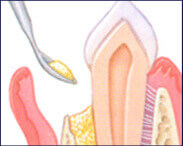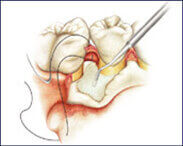Bone Grafting

Over time, periodontal disease can lead to breakdown of the bone and supporting structures that anchor the teeth into the jawbone. Bone Grafts are placed by periodontists with the goal of regenerating the bone lost from periodontal disease.
The bone grafting procedure, also known as "guided tissue regeneration", is comprised of a few basic steps.
The first step after getting the affected tooth comfortable and numb is to gently reflect the gum tissue. Any diseased gum tissue is removed, and the root of the tooth is thoroughly cleaned. What often remains is a crater in the jawbone that has resulted from infection.
Sometimes the periodontist will deposit a substance onto the root of the tooth and into the bone crater, which enhances the success of the Bone Grafting .
Then a completely sterile Bone Grafting is placed, which over time will become replaced by the body's own natural bone.
A membrane is placed over the Bone Grafting to prevent the gum tissue from growing into the Bone Grafting and to help contain the particles of the graft.
The gum tissue is re-positioned over the Bone Grafting and membrane, and sutures are placed.
The periodontist will go over home instructions and provide prescriptions for the appropriate medications. A one-week follow-up is needed to observe healing and to make sure no infection develops.
Bone grafting ing is a remarkable procedure that can adds years of life to teeth with bone loss.

